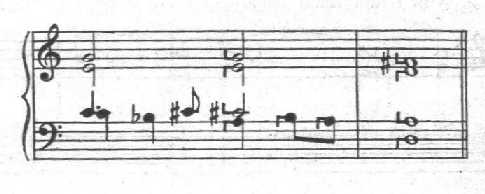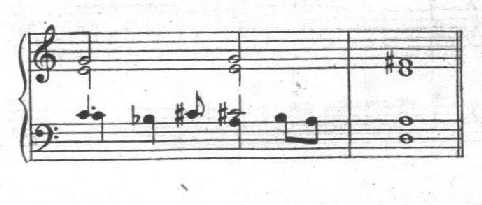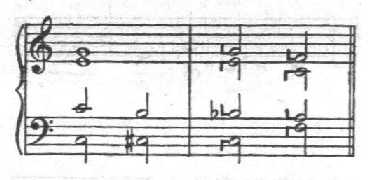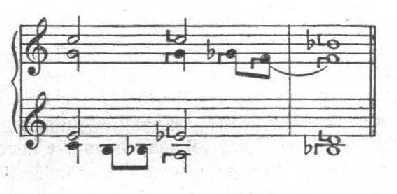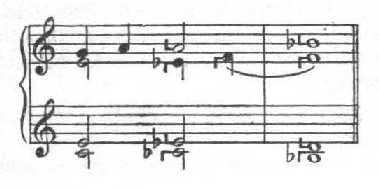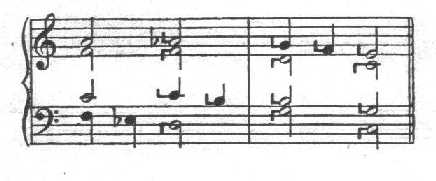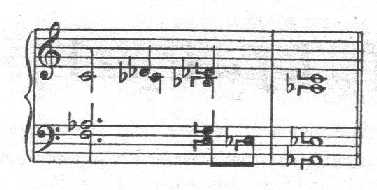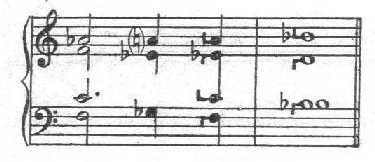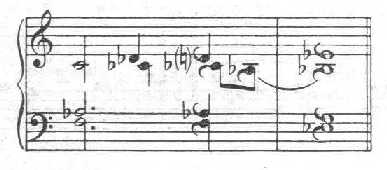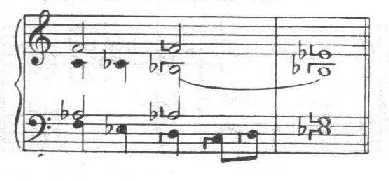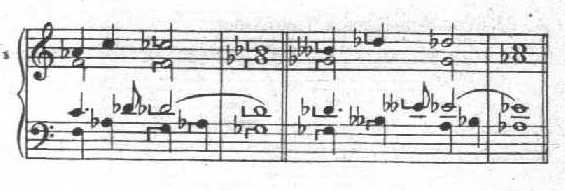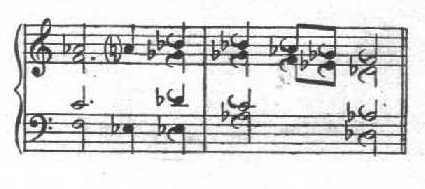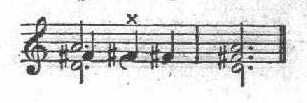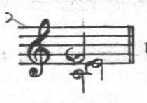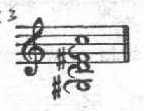|
Die Modulationen nach den bichromatisch benachbarten
Tonarten stelle ich von jetzt ab nicht mehr daneben,
da die bisherigen Beispiele hinreichend bewiesen haben
dürften, dass das Ohr jedes halbwegs musikalischen
Mittel-Europäers mit Leichtigkeit die Viertelton-Differenz
wahrnimmt, und sich die pp. korrespondierenden Übergänge ja
auch sehr leicht ohne besondere Noten konstruieren lassen.
|
I will not supply modulations to the bichromatically adjacent keys any more since the past examples should have proven sufficiently that the ear of every Central European who is tolerably musical will be able to perceive the quarter tone difference with ease. Besides, the transitions corresponding to the following examples can very easily be construed without resorting to written music.
|
|
Was die ästhetische Wirkung der einzelnen bichromatischen
im Vergleich zu der entsprechenden alten Modulation
betrifft, so wirkt diese meist grobkörnig, plump, während
der Viertelton-Übergang daneben ganz wundersam weich,
"verschleiert" anmutet. So meinte jedenfalls unlängst Walter
Dahms in der "Kreuz-Zeitung" (Berlin, 19.August 1916). Und
|
Concerning the aesthetic effect of the individual bichromatic modulations compared with the corresponding old ones, they usually appear coarse-grained, awkward, whereas the quarter-tone transition seems quite wondrously soft and "veiled" next to it. This, anyway, is what Walter Dahms in the "Kreuz-Zeitung" (Berlin, 19 August 1916) recently thought. And
|
|
[- 26 -]
|
|
|
Dr. Julius Bittner urteilt darüber in der "Neuen freien Presse"
(Wien, 25.Januar 1917): "Die Harmoniefolgen, die Möllendorff
in kurzfasslicher, instruktiver Weise brachte, erschienen
weicher, molliger, schmiegsamer als die gleichen Harmoniefolgen
auf dem alten modulatorischen Boden der einfachen
chromatischen Tonleiter." Ferner: "Manche Harmoniefolgen
in Vierteltönen hörten sich so weich, so flüssig an, dass
einem die darauf gespielte Harmoniefolge im alten Stile
fast grob, holprig vorkam." Ja, Bittner geht sogar so weit,
"von der Bichromatik ganz allgemein ein *Abnehmen* der
Dissonanzwirkung zu erwarten"! Dieser Ansicht ist übrigens
auch Dr. Leopold Schmidt. ("Berliner Tageblatt", 24.April 1917.)
|
Dr. Julius Bittner reviews them in the "Neue Freie Presse" (Vienna, 25 January 1917): "The harmonic progressions which Moellendorff performed in an easily comprehensible, instructive way, seemed to be softer, cozier, more flexible than the same harmony sequences on the old modulatory soil of the simple chromatic scale." Furthermore: "Some harmonic progressions in quarter-tones sounded so soft, so liquid that the harmonic progression played thereafter in the old style appeared almost rough, bumpy." Yes, Bittner generally even goes as far as to expect "on the whole, a *lessening of the dissonance effect from the bichromatic system"! This, by the way, is also the opinion of Dr. Leopold Schmidt. ("Berliner Tageblatt", 24 April 1917.)
|
|
7. Von C-dur nach Tief-As-dur:
|
7. From C-major to Deep-Ab-major:
|
|
Wir fragen uns nun: wie erklärt sich wohl die gute
Wirkung der vorstehenden Modulationen?
|
We wonder now: how can the good effect of the preceding modulations possibly be explained?
|
|
Nach solch einer Erklärung müssen wir schon suchen,
denn, ehrlich gesprochen: wir hatten bisher doch alle
geglaubt (meine Wenigkeit nicht ausgenommen): Musik mit
Vierteltönen würde, wenn sie überhaupt genießbar sei,
mindestens doch anfänglich sehr befremdlich klingen, und man
würde sich wohl erst ganz allmählich an die neuen Klänge
gewöhnen müssen. Und nun: keine dieser Befürchtungen ist
eingetreten! Die vorstehenden Akkordverbindungen waren
jedenfalls alle genießbar, und wenn hier von einer
Eingewöhnung des Ohres überhaupt die Rede sein kann, so
dauert diese höchstens ein paar Minuten. Danach kommen
einem die Vierteltöne dann schon wie das bekannteste Ding
von der Welt vor.
|
We reaaly have to look for such an explanation, for, in all honesty: hadn't we all (not excluding my own humble self) formerly thought that music with quarter tones, if it were at all palatable, would at least initially sound very strange and that one would have to accustom oneself to the new sounds gradually. And now: none of these apprehensions were needed! The preceding chord connections anyway were all agreeable, and if there is an acclimatizing of the ear at all to talk about, then it takes a few minutes at most. Thereafter, the quarter tones already seem to be the most familiar thing in the world.
|
|
Wie erklärt sich also diese zweifellos doch überraschende
Wirkung?
|
Well, what is the explanation for this certainly still surprising effect?
|
|
Nun, es kommen drei Gründe hierfür in Betracht:
|
There are three possible reasons for this:
|
|
Erstens: Alle diese Modulationen enthalten auch nicht
einen wirklich neuen, d.h.: einen *in sich* neuen
Akkord, sondern bringen immer nur bekannte
Akkorde auf neuen Stufen.
|
First of all: All these modulations don ot contain on single really new chord, i.e.: one new *in itself*, but only well-known chords on new scale degrees.
|
|
Zweitens: Da infolgedessen beim Übergehen aus einem
Akkord des alten in einen Akkord des neuen Systems
nun natürlicherweise niemals ein gemeinsamer Ton
als Bindeglied vorhanden war, so habe ich dabei
jedesmal die uralte Regel befolgt: Wo kein gemeinsamer
Ton, da Gegenbewegung.
|
Secondly: Since, of course, there consequently never was a common tone when changing from one chord of the old system into a chord of the new one to link them, I steadfastly obeyed the age-old rule: Where there is no common tone, use contrary motion.
|
|
Drittens: Ich habe jede einzelne Stimme immer nur
denjenigen der vielen möglichen neuen Schritte
ausführen lassen, der am allerwenigsten Überraschendes
für uns hat: den einfachen Vierteltonschritt.
|
Thirdly: I had each individual voice move in exactly the one of the many possible new steps that holds the least surprises for: the simple quarter tone step.
|
|
Man vergleiche daraufhin z.B. die Wirkung von:
|
One compare thereupon e.g. the effect of:
|
|
Auch die gute Wirkung aller dieser Übergänge erklärt
sich aus den bereits angeführten Gründen. Diese lauten
also, um es nochmals, und zwar recht kurzgefaßt, zu sagen:
1. Keine in sich neuen Akkorde!
2. Gegenbewegung!
3. Keinen anderen neuen Schritt als den Vierteltonschritt!
|
The good effect of all of these transitions is also explained by the reasons already stated. And they, just to repeat themin a quite abridged way, go:
1. No chords of a new construction!
2. Contrary motion!
3. No new step except for the quarter tone!
|
|
Diese drei Regeln beschränken nun das Gebiet der
Verwendungsmöglichkeit von Vierteltönen zweifellos ganz
bedeutend. Aber wollte man das Neuland wirklich auch
nur soweit beackern, als es eben diese drei Warnungstafeln
gestatten, so würde das für die musikalische Kultur doch
immerhin schon einen riesengroßen Geländegewinn bedeuten.
Jedoch: diese Paragraphen sind keineswegs ein für allemal
gültig. Sie enthalten nur die neuen Grundgesetze. Ihre
"Ausführungsbestimmungen" lassen hingegen wiederum viele,
viele Abweichungen zu. Um aber endlich nicht mehr durch
die Blume zu sprechen: Es sind also schließlich auch alle
|
Now these three rules indeed limit the range of application of quarter tones to quite an extent. But if one really wanted to cover the new ground only as far as even these three warning posts permit, it would still amoung to gaining a gingantic new area for the musical culture. However, these letters of the law are by no means valid once and for all. They only contain new constitution. Their "implementing regulations" however will permit many, many deviations again. But to quit talking in this veiled manner: Eventually, all the other
|
|
[- 34 -]
|
|
|
die anderen neuen Intervalle sowohl im Miteinander als im
Nacheinander verwendbar, es kommt dabei immer nur auf
die bekannten "näheren Umstände" an, die im Leben wie
in der Kunst ja schon von jeher eine so sehr große Rolle
spielen. Alles Reglementieren hört da eben auf, und nur
eine Entscheidung von Fall zu Fall ist noch möglich.
|
new intervals can be used both together and in succession, it all dependes on the well-known "closer circumstances", which have always played such a large role in life as in art. All rule making stops there, and only decisions for each individual case are possible.
|
|
Wenn wir uns nunmehr aber wenigstens einige dieser
Fälle betrachten, so dürfen wir uns dabei nicht wundern,
daß alle die neuen Intervalle *Dis*sonanzen sind. Denn neue
*Kon*sonanzen lassen sich ganz selbstverständlich überhaupt
nicht mehr finden. Nur eben die Zahl der Dissonanzen
kann durch die Einfügung von Vierteltönen um ein Gewaltiges
vermehrt werden. Aber: die die Dissonanz ist ja die eigentliche
Trägerin des musikalischen Ausdrucks, und gerade in
der Absicht, *diesen* zu verfeinern, zu differenzieren, haben
wir ja auch die Vierteltöne in das alte System eingeschaltet
Das Resultat, zu dem wir gelangt sind: eine Riesenfülle
neuer Dissonanzen, ist also gerade dasjenige, zu dem wir
gelangen wollten. Wir dürfen uns mithin dazu nur
gratulieren.
|
If we now, however, take a look at at least some these cases, it should not come as a surprise to us that all the new intervals are *dis*sonances. For, quite naturally, there aren't any new *con*sonances to be found any more. It is just the number of dissonances that can be increased by the insertion of quarter-tones by an enormous amount. However: the dissonance is the true medium of musical expression, and with exactly the intention of refining, differentiating *this*, we interpolated the quarter-tones into the old system in the first place. The result we arrived at, an overabundance of new dissonances, is thus just the one we wanted. So we may well congratulate ourselves.
|
|
Spielen nun aber schon bei unseren alten, allbekannten
Dissonanzen die näheren Umstände ihres Auftretens eine
große Rolle, so ist es klar, daß diese näheren Umstände
hier, wo es sich um ganz *neue* Dissonanzen handelt, von
noch viel größerer Wichtigkeit sein werden.
|
But if the closer circumstances of the occurrence of dissonances already play a large role with our old and familiar ones, it seems clear that these closer circumstances here, where completely * new * dissonances come into play, will be of still greater importance.
|
|
Greifen wir also aufs Geratewohl ein paar der neuen
Dissonanzen heraus, und sehen wir zu, unter welchen
Umständen wir sie schon heute, wo sie uns als Einzelwesen
noch gar nicht vertraut sind, verwenden können. (Wie
gesagt: nur das kleinste der neuen Intervalle, der einfache
Vierteltonschritt, wirkt im Nacheinander von vornherein
schön und durchaus nicht sonderlich neu oder gar häßlich.)
|
So let us pick a couple of the new dissonances at random and find out under which circumstances we can use them today even, when they individually are still quite unfamiliar to us. (As was already mentioned, only the smallest of the new intervals, the simple quarter tone step, does not appear either exceptionally new or even ugly from the outset.)
|
|
Das Intervall c - hoch-fis z.B.:
|
The interval C - high-F# (e.g.):
|
|
das Untier frißt einem dann sozusagen aus der Hand!
|
The beast will then eat from your hand, as it were!
|
|
Man sieht jedenfalls: viele der neuen Intervalle und
Akkorde werden sich durch irgendwelche, noch dazu
altbewährte "pädagogische" Mittel zu nützlichen Gliedern der
|
So one sees: many of the new intervals and chords can by some "educational" means, long-proven as they are, be made useful members of
|
|
[- 38 -]
|
|
|
neuen Tongesellschaft erziehen lassen. Aber leider natürlich
nicht alle! Es gibt unter ihnen vielmehr auch manche,
an denen einfach Hopfen und Malz verloren zu sein scheint.
Dazu zählen z.B. die folgenden beiden c - tief-e - tief-f:
|
the new tonal society. But unfortunately not all, of course! There are some among them that are rather hopeless cases. Among them are e.g. the following two, C - deep-E - deep-F:
|
|
Ein Komponist von Geschmack wird ganz selbstverständlich *)
derlei meist einfach vermeiden, wie er ja auch
schon heute bei weitem nicht alle überhaupt konstruierbaren
Tonkombinationen verwenden kann. Nur für ganz besondere
Zwecke, um diese ganz aparte Stimmung oder jenes
ganz aparte Bild malen zu können, wird er gelegentlich
auch solche harmonischen Unika, wenn auch immer nur
mit größter Vorsicht, benutzen dürfen, denn natürlich wollen
wir auch in Zukunft über die Schönheit nicht die Charakteristik
vergessen. Im übrigen läßt sich heute noch nicht
sagen, *wie weit* man nach dieser Richtung infolge
langsamer Eingewöhnung wird gehen können; denn daß *hier* die
Eingewöhnung eine sehr große Rolle spielen wird, dürfte
wohl außer allem Zweifel stehen.
|
A composer of taste will usually quite simply *) avoid any such, just as it is far from possible for him today to make use of all constructable tone combinations. He may use these harmonic singularities for very specific purposes only, in order to be able to paint this very distinctive mood or that very distinctive picture, although with the greatest caution in either case. For naturally, we do not want to forget the characteristic in the future for beauty. Besides that, there is no telling today how far one will be able to go in this direction after some slow acclimatization; since there probably isn't any doubt as to the very large role that getting used to them plays here.
|
|
Nun - und was die zahlreichen Komponisten *ohne*
Geschmack mit dem neuen System anstellen werden, das
kann uns eigentlich nur vollkommen gleichgültig sein. Ich
persönlich möchte hier nur noch rasch meine Hände in
Unschuld waschen und ebenso rasch noch bemerken, daß
man für einen Mißbrauch des Systems, sei es, welches es
sei! logischerweise doch niemals das betreffende arme
System verantwortlich machen kann. Welche Klangschönheiten
sich mit dem neuen Material erzeugen lassen,
|
Well - it need not concern us in the least here what the numerous composers without taste will do with the new system. I just quickly want to wash my hands in innocence and to remark just as quickly that, with some logic, one can never make the system responsible for its own misuse, whatever it may be. Which beauties of sound can be produced with the new material,
|
|
-----
*) Auch das Selbstverständliche muß hier leider gesagt werden,
wo leider nichts weiter selbstverständlich ist als Spott und Hohn
seitens ahnungsloser Beharrungsnaturen.
|
-----
*) It is a pity that the understood has to be stated here, where unfortunately nothing is understood but the mockery and scorn on the part of notionless pertinaceous characters.
|
[- 39 -]
|
|
|
davon geben ja wohl schon meine wenigen Beispiele einen
Begriff. Mit einigen kleinen Kompositionen für das
bichromatische Harmonium, die demnächst als Op. 26 im gleichen
Verlage wie diese Schrift erscheinen werden, hoffe ich aber
noch eingehender beweisen zu können, das die Worte
Vierteltonmusik und Mißklang keineswegs dasselbe zu
bedeuten haben. Darum, ihr Tondichter der Zukunft: auf
der früchteverheißenden Scholle der Schönheit mag euer
neuer Weizen blühen! Hier ist Rhodus, hier macht eure
Sprünge!
|
should be imagined from my few examples. But I hope to prove more impressively that the words quarter tone music and cacophony need not be synonyms in some small compositions for the bichromatic harmonium which will shortly be published as op. 26 by the same publishing house as this tract. Therefore, you tone poets of the future: may your wheat flower in the fruit-promising soil of beauty! Here is Rhodos, here make your jumps!
| |






